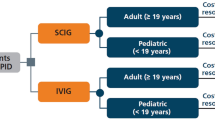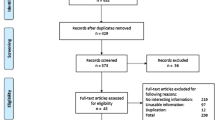Abstract
Primary antibody deficiencies are the most common forms of primary immunodeficiencies. Substitution therapy with polyvalent immunoglobulins has been established as the standard therapy for antibody deficiencies for several decades. Until now mainly intravenous immunoglobulins (IVIG) have been used in Germany, and the majority of patients receive treatment in hospital outpatient clinics. In recent years subcutaneous administration of immunoglobulins (SCIG) has been developed which is administered as home self-infusion. Studies indicate no significant differences in immunoglobulin substitution therapy between SCIG and IVIG concerning outcome. We carried out a cost-minimization analysis to compare the two treatment alternatives in Germany. Under base case assumptions the treatment with SCIG is cost saving from the perspective of the German statutory health insurance. The main cost drivers are IVIG and SCIG; the incremental cost of SCIG compared to IVIG is most sensitive to changes in the immunoglobulin price and changes in the body weight of the patient.


Similar content being viewed by others

References
Andersen V, Franke K, Erkel J et al. (2001) Subkutane IgG-Infusion bei Patienten mit primärem Immundefekt-eine retrospektive Fallsammlung. Mitt Bayer Ges Immun, Tropenmed Impfwesen 18:14
Borte M, Oertelt C, Keinecke HO et al. (2003) Die Behandlung des primären Antikörpermangels in Deutschland-Ergebnisse einer Umfrage. Monatsschr Kinderheilkd 151 [Suppl 1]:KHP 02.110
Chapel HM, Spickett GP, Ericson D et al. (2000) The comparison of the efficacy and safety of intravenous versus subcutaneous immunoglobulin replacement therapy. J Clin Immunol 20:94
Gardulf A, Hammarström L (1996) Subcutaneous administration of immunoglobulins—what are the advantages? Clin Immunother 6:108
Gardulf A, Andersen V, Björkander J et al. (1995) Subcutaneous immunoglobulin replacement in patients with primary antibody deficiencies: safety and costs. Lancet 345:365
Hansen S, Gustafson R, Smith CIE et al. (2002) Express subcutaneous IgG infusions: decreased time of delivery with maintained safety. Clin Immunol 104:237
Schöffski O, Uber A (2000) Grundformen gesundheitsökonomischer Evaluationen. In: Schöffski O, Graf v.d. Schulenburg M (eds) Gesundheitsökonomische Evaluationen, 2nd edn. Spinger, Berlin Heidelberg New York
Schwartz SA (2000) Intravenous immunoglobulin treatment of immunodeficiency disorders. Pediatr Clin North Am 47:1355
Sorensen RU, Moore C (2000) Antibody deficiency syndromes. Pediatr Clin North Am 47:1225
Conflict of interest:
No information supplied
Author information
Authors and Affiliations
Corresponding author
Additional information
An erratum to this article can be found at http://dx.doi.org/10.1007/s10198-005-0308-z
Rights and permissions
About this article
Cite this article
Högy, B., Keinecke, HO. & Borte, M. Pharmacoeconomic evaluation of immunoglobulin treatment in patients with antibody deficiencies from the perspective of the German statutory health insurance. Eur J Health Econ 6, 24–29 (2005). https://doi.org/10.1007/s10198-004-0250-5
Issue Date:
DOI: https://doi.org/10.1007/s10198-004-0250-5



